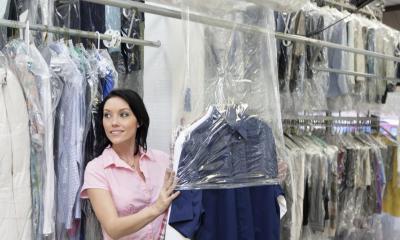
(last updated July 2019)
Dry cleaning has existed in its basic form for many years. However, technological improvements to both the machinery and the chemicals used have refined and improved the process over time, and the term 'dry cleaning' now includes a range of different techniques for removing stains and restoring an item to something approaching its original condition. There is now even an 'aqueous' dry cleaning system available, which uses water rather than chemical solvents. This is an important step in the light of growing awareness - and regulation - of the environmental and health and safety issues associated with some of the traditional dry cleaning solvents. For example, under the EC Solvents Emission Directive, you're not able to provide unattended coin-op dry cleaning equipment in your outlet and you instead need someone on hand to weigh all clothing before it is cleaned.
Green Earth dry cleaning is another recent development and, while it does use a chemical, the chemical is liquid silicone rather carbon based. There are a number of benefits to using this method of dry cleaning and details of these are given on the Green Earth website. The dry cleaning chain Johnsons offers Green Earth cleaning in its branches. Other systems that use alternative, non-perchloroethylene solvents such as hydrocarbon or the Solvon K4 organic solvent also exist.
According to government figures, consumer spending on cleaning and hiring of clothing was worth around £1 billion in 2009 having steadily increased since the mid 2000s but then fell to around £800 million by 2012 as many people cut their expenditure on certain goods and services as their disposable income levels were squeezed during the economic downturn. 2013 saw a tiny increase in spending on cleaning and hire of clothing and there was more significant growth in 2014 as the economy recovered and some consumer confidence returned, taking expenditure back up to around £1 billion. The economic recovery slowed in 2015 and into 2016 and the vote in June 2016 to leave the EU added further uncertainty to the economic outlook. Consumer spending on cleaning and hire of clothing grew by just under 4% during 2017 and remained subdued during 2018.
Social change
The last couple of decades have seen important social changes. Many more women go out to work every day, there are more single parent families than ever and single person households are on the increase. People have less and less spare time and they don't want to waste it doing unpleasant chores like laundry, ironing, sewing and so on. This is where the modern laundry and dry cleaning business comes in - many people don't mind paying for the convenience of having their laundry picked up from a nearby collection point and then dropped back a few days later, cleaned, pressed and neatly folded or packaged ready to go straight into the cupboard.
Not all social and technological changes have benefited the dry cleaning industry though. For example, where once people might have bought a few very expensive smart garments which they looked after and kept for years, many now buy lots of cheaper, fashionable items on a regular basis, which they often just throw away or forget about rather than paying for them to be dry cleaned.
Textile technology
Textile manufacturers have improved their products considerably over the years, meaning that fewer items now need to be dry cleaned. Man-made fibres often look very similar to more delicate and expensive natural textiles, but can be washed without shrinking or losing their shape.
In the meantime, the manufacturers of domestic laundry products have brought out 'home dry cleaning' solutions which can be used in a normal tumble dryer to dry clean many items.
Competition
The last few years have seen many of the big supermarkets offering dry cleaning services. They have realised that many people want a 'one-stop' outlet where they can take care of as many of their weekly chores as possible. Some have installed their own dry cleaning units, others have allowed major dry cleaning specialists to open concessions on their premises - for example Timpson outlets in Sainsbury's supermarkets - while still others have set up as 'receiving units', passing the items on to a local dry cleaning specialist. The mid-2010s saw Timpson greatly expand its number of stores, mainly through outlets located in supermarkets (or in their car parks) and by buying the Johnsons dry cleaning chain.
All of this means that the independent dry cleaner has to work hard to make sure of a steady stream of work. Running a successful laundry business today is all about finding out exactly what customers want. This might include other services like alterations, shoe repairs and key cutting - or it may just be straightforward dry cleaning at competitive prices with long shop opening hours.
Keeping up with developments
Joining a trade association is an excellent way of keeping up to date with the latest developments in your industry. There are three main associations serving the laundry industry in the UK:
- the Textile Services Association (TSA)
- the Guild of Cleaners and Launderers (GCL)
- the National Association of the Launderette Industry (NALI)
Visit their websites for more information.
Subscribing to a trade journal is another excellent way of keeping up to date with developments in the cleaning business. For example, Laundry and Cleaning Today and Laundry and Cleaning News are trade journals dedicated to the industry. Some trade associations also publish regular journals for their members.
Trade shows
You can get a lot of useful information by visiting a trade show for the dry cleaning and laundry sector, where you'll be able to meet manufacturers and suppliers. The GCL and TSA websites include details of upcoming trade shows, events and conferences - such as LCTCleanEx. The Exhibitions UK website also includes details of trade shows that may be of interest to you.


